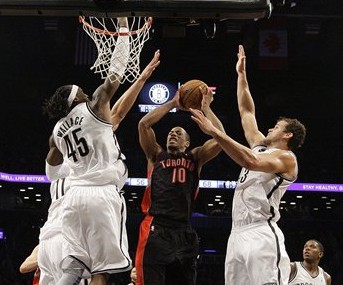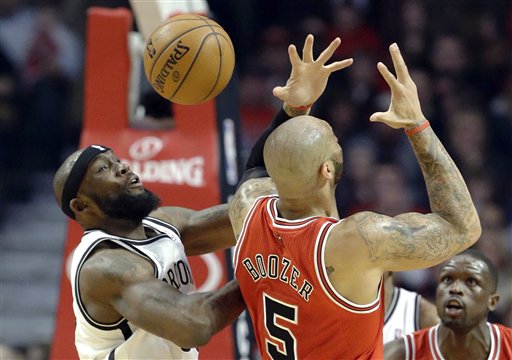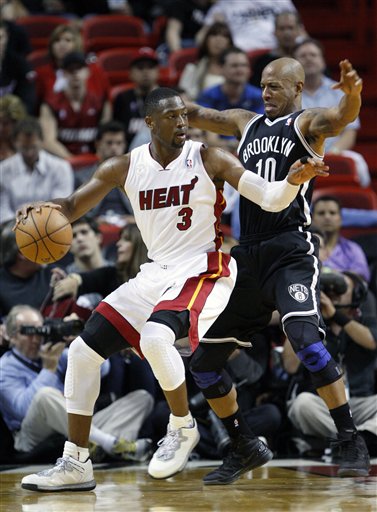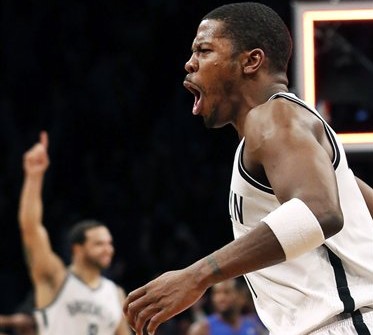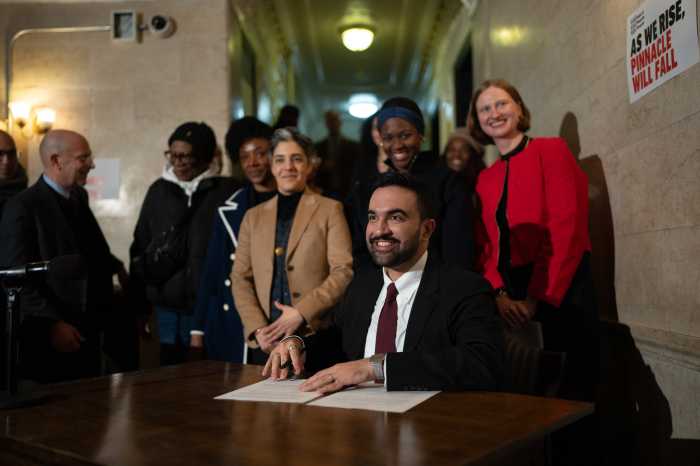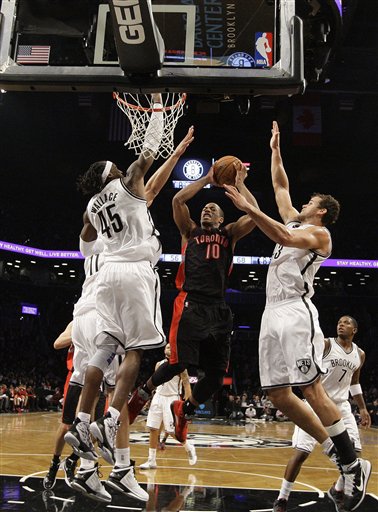
Or does it? What the debate ignores is that the Brooklyn Nets, whether they think so or not, already have a starting-quality power forward: starting small forward Gerald Wallace.
Wallace, of course, entered the league as a small forward. He’s been a small forward his entire career, save for one year in Charlotte. He’s known around the league as a small forward by reputation.
But when the Nets go small — putting the 6’7″ Wallace at power forward next to Lopez, and surrounding them with Deron Williams, Joe Johnson, and Keith Bogans — the look provides stunningly effective results. The unit outscores opponents by 20.7 points per 48 minutes and 23.5 points per 100 possessions, by far their most effective 5-man unit with more than 30 minutes played.
Wallace has said he’s accustomed to playing power forward before: “I’m kind of used to playing at the 4, banging with the bigs, going and getting rebounds … Whatever helps the team win.”
Brooklyn Nets coach P.J. Carlesimo does not feel the same way, as he told the Daily News last week he isn’t sold on the small-ball takeover. Carlesimo, incidentally, has used the lineup about as frequently as former coach Avery Johnson did, though he’s shied away from it in recent weeks.
With Reggie Evans or Kris Humphries in the game, Wallace’s ability to create points for others out of the high and low post gets severely limited. The Nets can’t keep Evans or Humphries outside of 15 feet and keep defenses honest at the same time. But when surrounded by three shooters in Williams, Johnson, and Bogans, the Nets can use the threat of Wallace’s varied skillset inside and out: setting flare screens for corner shooters, finding teammates for open looks from the post, and cutting to the basket for easy layups and dunks.
The numbers are strong: Wallace is far more effective as a cutter-screener than as a spot-up shooter. 33% of Wallace’s offense this season has come in spot-up situations, and he’s missed more than twice as many shots as he’s made, shooting just 31.8% in those situations with an effective field goal percentage (which adjusts for the value of three-pointers) of 43.5%.
But when used as a cutter — which is about 12% of his offense — Wallace’s effectiveness shoots up, with a field goal percentage of 64.7% (all on two-pointers) when the Nets find him going to the basket. (Additionally, in the extraordinarily small sample size of five plays, Wallace has hit all three of his shots and drawn two fouls when used as a pick-and-roll big man, scoring 12 points on just five plays.)
With Wallace as a power forward, the need for him to spot up becomes essentially nil. Wallace this season in all situations averages three 3-point attempts per 36 minutes, but in 86 minutes with the lineup, Wallace has only taken three three-pointers total, making one. The five-man unit as a whole shoots 44.4% from deep.
The balance works. In Williams and Johnson, the Nets have two dynamic wing scorers that can drive and hit outside shots (Williams more frequently in the past month). In Lopez, the Nets have their offensive monster. In Bogans, they have their outside fifth-option threat. The Nets don’t need Wallace to be a big scorer with this lineup, but enough of a threat that they can’t leave him inside or out, and a skilled enough passer/cutter that he can find open shooters and get free for the occasional easy dunk or layup.
With that five-man unit, 60% of the Nets shots come from either within five feet or from the corners — the most efficient spots on the floor. Put Evans at PF instead of Wallace, and the starting five the Nets most frequently use get 49.4% of their shots in those efficient areas.
The major issue with this lineup is the issue you’ll always have when you remove Reggie Evans from a lineup — rebounding. With the small look, the Nets only grab 48.1% of available rebounds (50%, for obvious reasons, is the league average). But that rebound difference is mitigated by this lineup’s ability to get excellent looks offensively, play a variety of offensive sets, and defend.
Defensively, this lineup is posting video game numbers — or, depending how you play, the opposite of video game numbers. In 86 minutes they’ve allowed just 90.1 points per 100 possessions despite giving up unseemly offensive rebounding numbers. Wallace’s individual defensive acumen against power forwards is questionable — he’s giving up a PER around 20 to power forwards this season, per 82games.com — but he is this team’s quickest rotator and best defender among its PF’s. Combined with Lopez’s improved defensive ability and Bogans’ intelligent defensive skillset he picked up under Tom Thibodeau, the team allows opponents to shoot under 44% from within five feet and has allowed just four attempts total from the corners.
Johnson & Carlesimo often use(d) this lineup in matchup situations. It was Johnson’s go-to lineup against teams with small fours, like Philadelphia’s Thaddeus Young. But it’s seen effective minutes, even in limited time, against bigger teams. (One example — one of the few good stretches in Christmas Day’s 93-76 blowout came in the four minutes those five shared the floor.)
Looking at the power forward landscape, unless the Nets make a trade — which, as always with the Nets, is extraordinarily possible — Brooklyn fans may already have the starting PF they’re looking for. Evans is a surprisingly good passer for a man of his skills and reputation, but Wallace is arguably this team’s second-best creator. Mirza Teletovic can shoot, but doesn’t have Wallace’s defensive acumen, and Bogans/Johnson defend wings well enough to mitigate Wallace’s move. Kris Humphries looks like a man possessed, and not in the good way. It’s the individual, significant flaws each of these players has that have caused Nets fans (and us) to look elsewhere.
But the answer you’re looking for may already be in Brooklyn.

